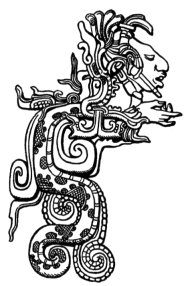
Palenque, also anciently known in the Itza Language as Lakamha, was a Maya city-state in southern Mexico that perished in the 8th century. The Palenque ruins date from ca. 226 BC to ca. 799 AD. After its decline, it was overgrown by the jungle of cedar, mahogany, and sapodilla trees, but has since been excavated and restored. It is located near the Usumacinta River in the Mexican state of Chiapas, about 130 km (81 mi) south of Ciudad del Carmen, 150 meters (490 ft) above sea level. It is adjacent to the modern town of Palenque, Chiapas. It averages a humid 26 °C (79 °F) with roughly 2,160 millimeters (85 in) of rain a year.

Kʼawiil, in the Post-Classic codices corresponding to God K, is a Maya deity identified with power, creation, and lightning. He is characterized by a zoomorphic head, with large eyes, long, upturned snout and attenuated serpent foot. As a creator god, K'awiil usually has a torch, stone celt, or cigar coming out of his forehead that symbolizes the spark of life. One of his legs does not end in a foot but in a snake with an open mouth, from which another being can emerge. As lightning and power personified, K'awiil is often carried like an axe by rain gods or as a sceptre by Maya rulers.
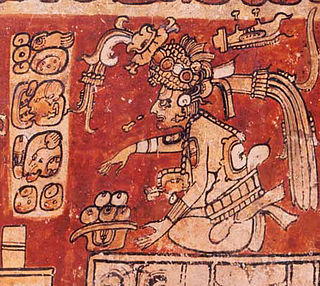
Itzamná is, in Maya mythology, an upper god and creator deity thought to reside in the sky. Itzamná is one of the most important gods in the Classic and Postclassic Maya pantheon. Although little is known about him, scattered references are present in early-colonial Spanish reports (relaciones) and dictionaries. Twentieth-century Lacandon lore includes tales about a creator god who may be a late successor to him. In the pre-Spanish period, Itzamná was often depicted in books and in ceramic scenes derived from them. Before the names of the Maya deities were deciphered, Itzamná was known as "god D", and is still sometimes referred to as "god D" by archeologists.

Bonampak is an ancient Maya archaeological site in the Mexican state of Chiapas. The site is approximately 30 km (19 mi) south of the larger site of the people Yaxchilan, under which Bonampak was a dependency, and the border with Guatemala. While the site is not overly spatial or abundant in architectural size, it is well known for the murals located within the three roomed Structure 1. The construction of the site's structures dates to the Late Classic period. The Bonampak murals are noteworthy for being among the best-preserved Maya murals.

Yaxchilan is an ancient Maya city located on the bank of the Usumacinta River in the state of Chiapas, Mexico. In the Late Classic Period Yaxchilan was one of the most powerful Maya states along the course of the Usumacinta River, with Piedras Negras as its major rival. Architectural styles in subordinate sites in the Usumacinta region demonstrate clear differences that mark a clear boundary between the two kingdoms.

Kʼinich Janaab Pakal I, also known as Pacal or Pacal the Great, was ajaw of the Maya city-state of Palenque in the Late Classic period of pre-Columbian Mesoamerican chronology. He acceded to the throne in July 615 and ruled until his death. Pakal reigned 68 years—the fifth-longest verified regnal period of any sovereign monarch in history, the longest in world history for more than a millennium, and still the longest reign of any monarch in the history of the Americas. During his long rule, Pakal was responsible for the construction or extension of some of Palenque's most notable surviving inscriptions and monumental architecture. He is perhaps best known in popular culture for his depiction on the carved lid of his sarcophagus, which has become the subject of pseudoarchaeological speculations.
In pre-Columbian Maya civilization, ceremonial dance had great importance. However, since dance is a transient art, it is inherently difficult for archeologists to find and evaluate evidence of its role. There is little material information left behind, beyond a few paintings on murals and vases. This lack of direct evidence leads to several different archaeological interpretations.
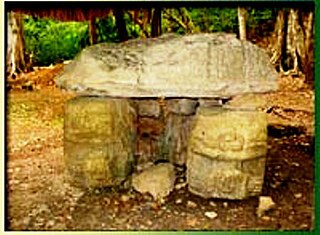
El Perú, is a pre-Columbian Maya archeological site occupied during the Preclassic and Classic cultural chronology periods. The site was the capital of a Maya city-state and is located near the banks of the San Pedro River in the Department of Petén of northern Guatemala. El Perú is 60 km (37 mi) west of Tikal.

K’uk’ulkan, also spelled Kukulkan, is the serpent deity of Maya mythology. It is closely related to the deity Qʼuqʼumatz of the Kʼicheʼ people and to Quetzalcoatl of Aztec mythology. Prominent temples to Kukulkan are found at archaeological sites in the Yucatán Peninsula, such as Chichen Itza, Uxmal and Mayapan.
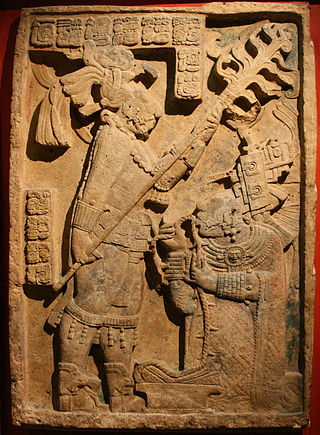
Lintel 24 is the designation given by modern archaeologists to an ancient Maya limestone sculpture from Yaxchilan, in modern Chiapas, Mexico. The lintel dates to about 723–726 AD, placing it within the Maya Late Classic period. Its mid-relief carving depicts the ruler of Yaxchilan, Itzamnaaj Bahlam III, and his consort Lady K’abal Xoc, performing a ceremony of bloodletting; the imagery is also accompanied by descriptive captions, and a signature by the sculptor, Mo’ Chaak.
Bloodletting was the ritualized practice of self-cutting or piercing of an individual's body that served a number of ideological and cultural functions within ancient Mesoamerican societies, in particular the Maya. When performed by ruling elites, the act of bloodletting was crucial to the maintenance of sociocultural and political structure. Bound within the Mesoamerican belief systems, bloodletting was used as a tool to legitimize the ruling lineage's socio-political position and, when enacted, was important to the perceived well-being of a given society or settlement.

Cerros is an Eastern Lowland Maya archaeological site in northern Belize that functioned from the Late Preclassic to the Postclassic period. The site reached its apogee during the Mesoamerican Late Preclassic and at its peak, it held a population of approximately 1,089 people. The site is strategically located on a peninsula at the mouth of the New River where it empties into Chetumal Bay on the Caribbean coast. As such, the site had access to and served as an intermediary link between the coastal trade route that circumnavigated the Yucatán Peninsula and inland communities. The inhabitants of Cerros constructed an extensive canal system and utilized raised-field agriculture.

World trees are a prevalent motif occurring in the mythical cosmologies, creation accounts, and iconographies of the pre-Columbian cultures of Mesoamerica. In the Mesoamerican context, world trees embodied the four cardinal directions, which also serve to represent the fourfold nature of a central world tree, a symbolic axis mundi that connects the planes of the Underworld and the sky with that of the terrestrial realm.
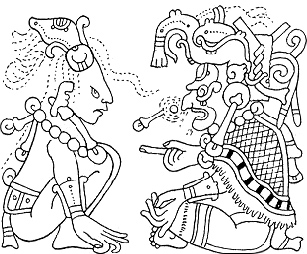
The traditional Maya or Mayan religion of the extant Maya peoples of Guatemala, Belize, western Honduras, and the Tabasco, Chiapas, Quintana Roo, Campeche and Yucatán states of Mexico is part of the wider frame of Mesoamerican religion. As is the case with many other contemporary Mesoamerican religions, it results from centuries of symbiosis with Roman Catholicism. When its pre-Hispanic antecedents are taken into account, however, traditional Maya religion has already existed for more than two and a half millennia as a recognizably distinct phenomenon. Before the advent of Christianity, it was spread over many indigenous kingdoms, all with their own local traditions. Today, it coexists and interacts with pan-Mayan syncretism, the 're-invention of tradition' by the Pan-Maya movement, and Christianity in its various denominations.
Ancient Maya art comprises the visual arts of the Maya civilization, an eastern and south-eastern Mesoamerican culture made up of a great number of small kingdoms in what is now Mexico, Guatemala, Belize and Honduras. Many regional artistic traditions existed side by side, usually coinciding with the changing boundaries of Maya polities. This civilization took shape in the course of the later Preclassic Period, when the first cities and monumental architecture started to develop and the hieroglyphic script came into being. Its greatest artistic flowering occurred during the seven centuries of the Classic Period.

Lady Kʼabʼal Xook or Lady Xoc, was a Maya Queen consort of Yaxchilan. She was the principal wife and aunt of King Itzamnaaj Bahlam III, who ruled the prominent kingdom of Yaxchilan from 681 to 742. She is believed by many to have been the sister of Lady Pacal.

Yaxun Bʼahlam IV, also called Bird Jaguar IV, was a Mayan king from Yaxchilan. He ruled from 752 until 768 AD, continuing the period of prosperity started by his father Itzamnaaj Bʼahlam III. He had to struggle to take and hold power, as he was not perceived to be the rightful heir to the throne.
During the 6th and 7th centuries in Mesoamerica, there was an evident shift in the roles women played in ancient Maya society as compared with the previous two centuries. It was during this time that there was a great deal of political complexity seen both in Maya royal houses as well as in the Maya area. Warfare was a significant factor in political competition and marriage was one of the ways that alliances were made between the different polities. This was accompanied by a shift in women's roles from wife and mother to playing integral parts in courtly life, such as participating in rituals involving the supernatural world and at times ruling individual polities.
Wayob is the plural form of way, a Maya word with a basic meaning of 'sleep(ing)', but which in Yucatec Maya is a term specifically denoting the Mesoamerican nagual, that is, a person who can transform into an animal while asleep in order to do harm, or else the resulting animal transformation itself. Already in Classic Maya belief, way animals, identifiable by a special hieroglyph, had an important role to play.

Itzamnaaj Bahlam III was a Mayan king of the city of Yaxchilan which is now located in Chiapas, Mexico. He rose to power in October 681 and continued to rule until his death in June 742. Itzamnaaj Bahlam III is best known for the many buildings and stelae he commissioned during his rule, many of which are still found at Yaxchilan today. He was spouse to Lady Ik' Skull who herself ruled for a time.
